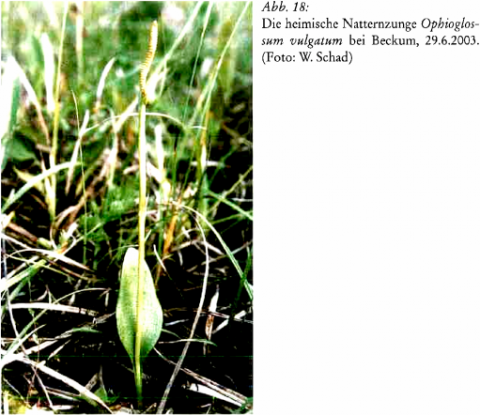Von Bärlappen, Mondrauten und Natternzungen
Export Article Citation as
- Download price : €6
Abstract:
Clubmosses, grape-ferns and Adder’s-tongue ferns
The clubmosses (Lycopodiaceae), grape-ferns (Botrychium) and Adder’s-tongue ferns (Op/aioglossum) are rclatively rare groups of pteridophytes in the European flora. Here we help to analyze the different species in the field as well as to grasp the obvious coherence of these differences. Thus, in the course of evolution of the clubmosses from the more primitive to the more derived members‚ we encounter an increasing polarisation in the shape of both the rhizome-root system and the generative organ system. In the grape-ferns there is a strong connection between size and the morphological differentiation of the plant - often known though not mentioned. The first fossil ancestors of the pteridophytes in Devonian times are also mentioned.
References
- BRUCHMANN, H. (1885): Prothallium von Lycopodium annotinum. Botanisches Zentralblatt 1
- BRUCHMANN, H. (1898): Über die Prothallien und Keimpflanzen mehrerer europäischer Lycopodien. Gotha
- BRUCHMANN, H. (1910): Die Keimung der Sporen und die Entwicklung der Prothallien von Lycopodium clavatum L., L. annotinum L. und L. selago. Flora 101: 220 - 267
- EBERLE, G. (19702): Farne im Herzen Europas. W. Kramer Frankfurt a. M.
- FREEBERG, J. A. (1962): Lycopodium prothalli and their Endophytic Fungi as Studied In Vitro. American Journal of Botany 49: 530 - 535
- FUKAREK, F. (1992): Pteridophyta. In: Urania-Pflanzenreich, Bd. 2. Leipzig, Jena, Berlin
- GAMS, H. (19735): Kleine Kryptogamenflora, Bd. IV: Die Moos- und Farnpflanzen. G. Fischer Stuttgart
- GARVE, E. & HULLEN, M. (2002): Flora und Vegetation im Nationalpark Harz (Exkursion D). Tuexenia 22: 127 - 150. Göttingen
- HIRMER, M. (1927): Handbuch der Paläobotanik, Bd. 1, S. 184. München, Berlin
- HORN, K. (1997): Verbreitung, Ökologie und Gefährdung der Flachbärlappe [...] in Niedersachsen und Bremen. Naturschutz u. Landespflege Niedersachsen H. 38: 1 - 83. Hannover
- HORN, K. & BENNERT, H. W. (2002): Diphasiastrum oellgaardii [...], eine neue Flachbärlapp-Art für die Flora von Österreich. Phyton 42(1): 125 - 148. Horn/Österr.
- KRÄUSEL, R. & WEYLAND, H. (1933): Die Flora des böhmischen Mitteldevons. Palacontographica 78 (B): 1 - 46
- MEUSEL, W & HEMMERLING, J. (1969): Die Bärlappe Europas. Ziemsen Wittenberg-Lutherstadt
- NESSEL, H. (1939): Die Bärlappgewächse. G. Fischer Jena
- NINAN, C. A. (1958): Studies on the Cytology and Phylogeny of the Pteridophyta. VI: Observations on the Ophioglossaceae. Cytologia 23: 291 - 316
- PIROZYNSKI, K. A. & Malloch, D. W. (1975): The Origin of Landplants: A Matter of Mycotr0phism. Biosystems 6: 153 - 164
- PROBST, W (1987): Biologie der Moos- und Farnpflanzen. UTB 1418. Heidelberg, Wiesbaden
- RASBACH, K., RASBACH, H. & WILMANNS, 0. (19762): Die Farnpflanzen Zentraleuropas. G. Fischer Stuttgart
- ROTHMALER, W (1987): Exkursionsflora, Bd. 3. Berlin-Ost
- SCHWEITZER, H.-J. (1966): Die Mitteldevon-Flora von Lindlar (Rheinland). 1. Lycopodiinae. Palaeontographica 118 (B): 93 - 112
- SCHWEITZER, H.-J. (1990): Pflanzen erobern das Land. Frankfurt a. M.
- STEINER, R. (1924): Heilpädagogischer Kurs (GA 317), 10. Vortrag vom 5.7.1924, S. 151. Dornach 1965
- STEWART, W. N. & ROTHWELL, G. W (19932): Paleobotany and the Evolution of Plants. Cambridge University Press Cambridge/UK.
- STRASBURGER, E. & al. (1978): Lehrbuch der Botanik für Hochschulen. Fischer Verlag Stuttgart, New York
- WARBURG, O. (1923): Die Pflanzenwelt, Bd. 1 - 3. Leipzig

